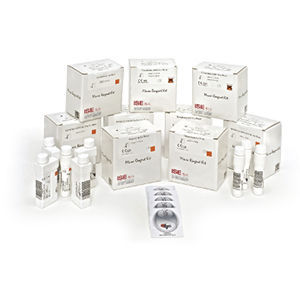
Clinical chemistry reagent kit A-R0200000801 blood samplefor urine samplesmagnesium
Add to favorites
Compare this product
fo_shop_gate_exact_title
Characteristics
- Applications
- for clinical chemistry, blood sample, for urine samples
- Tested parameter
- magnesium
Description
Product for use in the quantitative determination in vitro of the concentration of
Magnesium in human serum, plasma and urine. The results of the test must always be
interpreted in conjunction with the clinical picture. For professional use only.
About 55% of the total magnesium present in the human body is found in the bone,
while the remaining portion is within the cells, bound to proteins or molecules with a
negative charge. About 55% of the magnesium present in the serum is free, 30% is
bound to proteins and 15% is in the form of compounds bound to phosphate or citrate
ions. It is of fundamental importance in oxidative phosphorylation, in glycolysis and in
cellular replication. The reference method for the determination of magnesium in serum
and urine makes use of atomic absorption spectrophotometry. For routine diagnostic
use, colorimetric assay methods have been developed based on compounding
reactions between colouring substances (calmagite, methylthymol blue, titanium yellow,
non-sulphonated derivatives of xylidyl-blue, xylidyl-blue). The reagent makes use of
xylidyl blue which is more sensitive than other stains. Like the other colouring
substances, it also compounds cations other than magnesium, and in particular
calcium, and it must therefore be associated with a chelating agent which eliminates
this type of interference (1.2).
Catalogs
No catalogs are available for this product.
See all of ISE‘s catalogsRelated Searches
- Solution reagent kit
- Laboratory reagent kit
- Protein reagent kit
- Clinical chemistry reagent
- Antibody
- Clinical chemistry analyzer
- Automatic clinical chemistry analyzer
- Blood sample reagent kit
- Benchtop clinical chemistry analyzer
- Electrolyte reagent kit
- Blood clinical chemistry analyzer
- Enzyme reagent
- Random access biochemistry analyzer
- Clinical chemistry analyzer with ISE
- Serum clinical chemistry analyzer
- Plasma clinical chemistry analyzer
- Biochemistry analyzer with touchscreen
- Compact clinical chemistry analyzer
- Reagent for antigens
- Urine clinical chemistry analyzer
*Prices are pre-tax. They exclude delivery charges and customs duties and do not include additional charges for installation or activation options. Prices are indicative only and may vary by country, with changes to the cost of raw materials and exchange rates.







